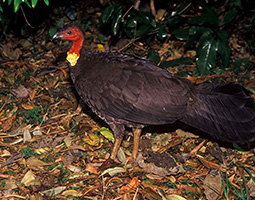Alectura lathami
Description
 The Australian Brush Turkey is found along the east coast of Australia from the tip of Cape York to the southern coast of New South Wales. Within this range, this plump bird particularly likes inhabiting areas like rainforests and wet sclerophyll forests, but may be found in drier woodlands as well. These ground-dwelling birds are easily distinguished from other birds with their blue-black feathers, bare red head and bright yellow wattle around the neck.
The Australian Brush Turkey is found along the east coast of Australia from the tip of Cape York to the southern coast of New South Wales. Within this range, this plump bird particularly likes inhabiting areas like rainforests and wet sclerophyll forests, but may be found in drier woodlands as well. These ground-dwelling birds are easily distinguished from other birds with their blue-black feathers, bare red head and bright yellow wattle around the neck.
Male turkeys can build massive nesting mounds that are about 4 metres in diameter and 1 metre high. Within these nests, they may incubate up to 50 eggs from many different females. After about 50 days, the eggs hatch and the chicks burrow out of the nests.
The nesting and feeding behaviour of scrub turkeys in urban environments can cause a problem when they destroy people's gardens as they scratch through the leaves.
Adaptations
- Very large feet for raking up leaves to construct nests and search for food.
- Check the temperature of their nests by taking a mouthful of compost and using special heat sensors inside their upper bill.
- Maintain the internal temperature of the nest at approximately 33–38 degrees Celsius by removing layers of leaves off the top of the nest.
- Roost in trees at night to avoid predators while sleeping.
Feeding relationships
- What I eat: insects, seeds and fallen fruits.
- What eats me: goannas (large Australian monitor lizards), carpet snakes, dingoes, foxes, feral cats, dogs, eagles.
Interesting facts
Unlike the hatchlings of many birds, brush turkey chicks are fully feathered and are able to walk, fly and fend for themselves a few hours after hatching.